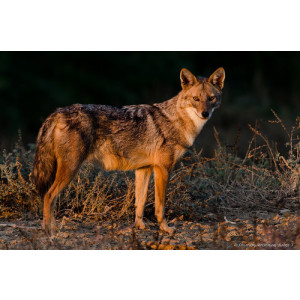Grey Wolf Did you see this animal?
Scientific Name : Canis lupus
Family : Canidae
Order : Carnivora
Class : Mammalia
Phylum : Chordata
Other Name : Tundra Wolf, Artic Wolf
Habitat : Forest, Shrubland, Grassland, Wetlands (inland), Rocky areas (eg. inland cliffs, mountain peaks), Desert
Description : Gray wolves are large carnivores, with a body length ranging from 1 to 1.5 meters and a shoulder height of up to 90 cm. They can weigh up to 80 kg, depending on their habitat and subspecies.
Their fur color can vary from gray to brown, black, and even white, depending on the region they inhabit. Their fur is thick and provides insulation in cold environments.
Gray wolves are highly adaptable and can live in a variety of habitats, including forests, grasslands, and deserts. They have a complex social hierarchy and live in packs, which can range from 2 to 30 individuals.
Their diet mainly consists of large mammals, such as deer, elk, and moose, but they can also feed on smaller prey and carrion. They are apex predators and play an important role in their ecosystems by controlling the populations of prey species.
Gray wolves are highly intelligent and have a sophisticated communication system, including vocalizations, body language, and scent marking. They have a strong sense of loyalty to their pack and exhibit cooperative hunting behavior.
Mating occurs between January and March, and after a gestation period of 63 days, females give birth to litters of 4 to 6 pups. Both parents take care of the young, and the pups stay with the family group for several months before they become independent.
Gray wolves have been historically persecuted by humans, and their populations have declined in many regions due to habitat loss, hunting, and conflicts with humans. However, conservation efforts have led to their recovery in some areas, and they are now protected by law in many countries.
In conclusion, gray wolves are fascinating and important canid species that play a crucial role in their ecosystems. It is important to protect them and their habitat to ensure their survival and maintain the balance of their ecosystems.
Their fur color can vary from gray to brown, black, and even white, depending on the region they inhabit. Their fur is thick and provides insulation in cold environments.
Gray wolves are highly adaptable and can live in a variety of habitats, including forests, grasslands, and deserts. They have a complex social hierarchy and live in packs, which can range from 2 to 30 individuals.
Their diet mainly consists of large mammals, such as deer, elk, and moose, but they can also feed on smaller prey and carrion. They are apex predators and play an important role in their ecosystems by controlling the populations of prey species.
Gray wolves are highly intelligent and have a sophisticated communication system, including vocalizations, body language, and scent marking. They have a strong sense of loyalty to their pack and exhibit cooperative hunting behavior.
Mating occurs between January and March, and after a gestation period of 63 days, females give birth to litters of 4 to 6 pups. Both parents take care of the young, and the pups stay with the family group for several months before they become independent.
Gray wolves have been historically persecuted by humans, and their populations have declined in many regions due to habitat loss, hunting, and conflicts with humans. However, conservation efforts have led to their recovery in some areas, and they are now protected by law in many countries.
In conclusion, gray wolves are fascinating and important canid species that play a crucial role in their ecosystems. It is important to protect them and their habitat to ensure their survival and maintain the balance of their ecosystems.
Distribution in Bangladesh
References:
description written by:Asad U. Tanvir,Department of Zoology,Jagannath University,Dhaka; reviewed by:Muntasir Akash,Department of Zoology,University of Dhaka;Taxonomic Checklist:Red List of Bangladesh Volume 2: Mammals, 2015, IUCN; information sources:wikipedia,iucnredlist.org; photo credit:Matt(www.inaturalist.org/people/gmucientes), photo copyright: iNaturalist.more information please contact with us.
description written by:Asad U. Tanvir,Department of Zoology,Jagannath University,Dhaka; reviewed by:Muntasir Akash,Department of Zoology,University of Dhaka;Taxonomic Checklist:Red List of Bangladesh Volume 2: Mammals, 2015, IUCN; information sources:wikipedia,iucnredlist.org; photo credit:Matt(www.inaturalist.org/people/gmucientes), photo copyright: iNaturalist.more information please contact with us.
































